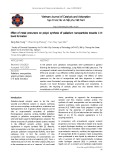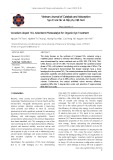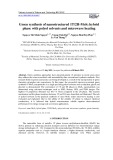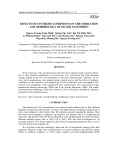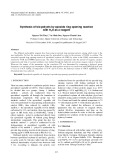
Polyol synthesis
-
Effect of metal precursors on polyol synthesis of palladium nanoparticles towards C-N bond formation
In the present work, palladium nanoparticles were synthesized in glycerol following the bottom-up methodology, using Pd(II) and Pd(0) precursors. The as-prepared materials were characterized by transmission electron microscopy (TEM) and powder X-ray diffraction (XRD), evidencing the formation of zerovalent palladium spheres in the nanosize ranges.
 5p
5p  vikwong
vikwong
 29-09-2024
29-09-2024
 3
3
 1
1
 Download
Download
-
This study focuses on the synthesis of V-doped TiO2 materials using a modified polyol method to enhance their efficiency. The obtained materials were characterized by various methods such as XRD, EDX, FTIR, SEM, TEMSAED, Raman, and UV-Vis DRS. The results indicated the crystalline anatase phase of TiO2, with spherical morphology and an average size of 30nm. The UV-DRS measurement demonstrated that doped materials have a lower bandgap than the pristine TiO2.
 6p
6p  vikwong
vikwong
 29-09-2024
29-09-2024
 1
1
 1
1
 Download
Download
-
Green synthesis of nanostructured 1T/2H-MoS2 hybrid phase with polyol solvents and microwave heating
This study aims to investigate the effectiveness of the green microwave technique in producing 1T/2H-MoS2 nanomaterials using polyol solvents. The paper presents a thorough analysis of the structural and property characteristics of the synthesized materials and elucidates the underlying chemical mechanism that governs the formation of hybrid-phase nanostructures. Additionally, the role of polyol solvents in the practical synthesis of nano MoS2 under microwave heating is evaluated and explained.
 15p
15p  xuanphongdacy06
xuanphongdacy06
 18-09-2024
18-09-2024
 1
1
 1
1
 Download
Download
-
The results show that the cerium oxide spherical nanoparticles built from primary nanoparticles with the average size of ~5 nm, exhibited dispersion and uniform size and shapes with their average particle diameter of ~50 nm in size. With such a good morphology, CeO2 material possessed good catalytic activity for the decomposition of methylene blue (MB), in which the material was synthesized at a hydrothermal temperature of 80 oC (CeO2-80) for the best MB decomposition performance.
 10p
10p  meyerowitz
meyerowitz
 25-12-2021
25-12-2021
 5
5
 0
0
 Download
Download
-
Silver nanowires with one-dimensional structures have attracted much research interest due to their potential applications in several areas. It is well-known that their properties strongly depend on the size and morphology of the silver nanostructures. Therefore, in our work, silver nanostructures were prepared using a polyol process and the effects of synthesis conditions on the formation and morphology of silver nanowires were investigated.
 8p
8p  abcxyz123_02
abcxyz123_02
 03-03-2020
03-03-2020
 15
15
 3
3
 Download
Download
-
The effect of reaction parameters like the amount of reagents, catalyst, temperature and time of a polyol synthesis were studied through the hydroxyl and oxirane oxygen content of product. Moreover, the impact of the parameters on the correlation P/E was determined by comparing a hydroxyl group formation to an epoxide group consumption. When the hydroxylation reaction was carried out with ESO:H2O mole ratio of 1:15; in 8 wt.% H2SO4; at temperature of 70 oC and in 5 hours, the hydroxyl content of 358.51 mgKOH/g of the obtained product was achieved.
 6p
6p  bautroibinhyen211
bautroibinhyen211
 26-11-2018
26-11-2018
 36
36
 2
2
 Download
Download







